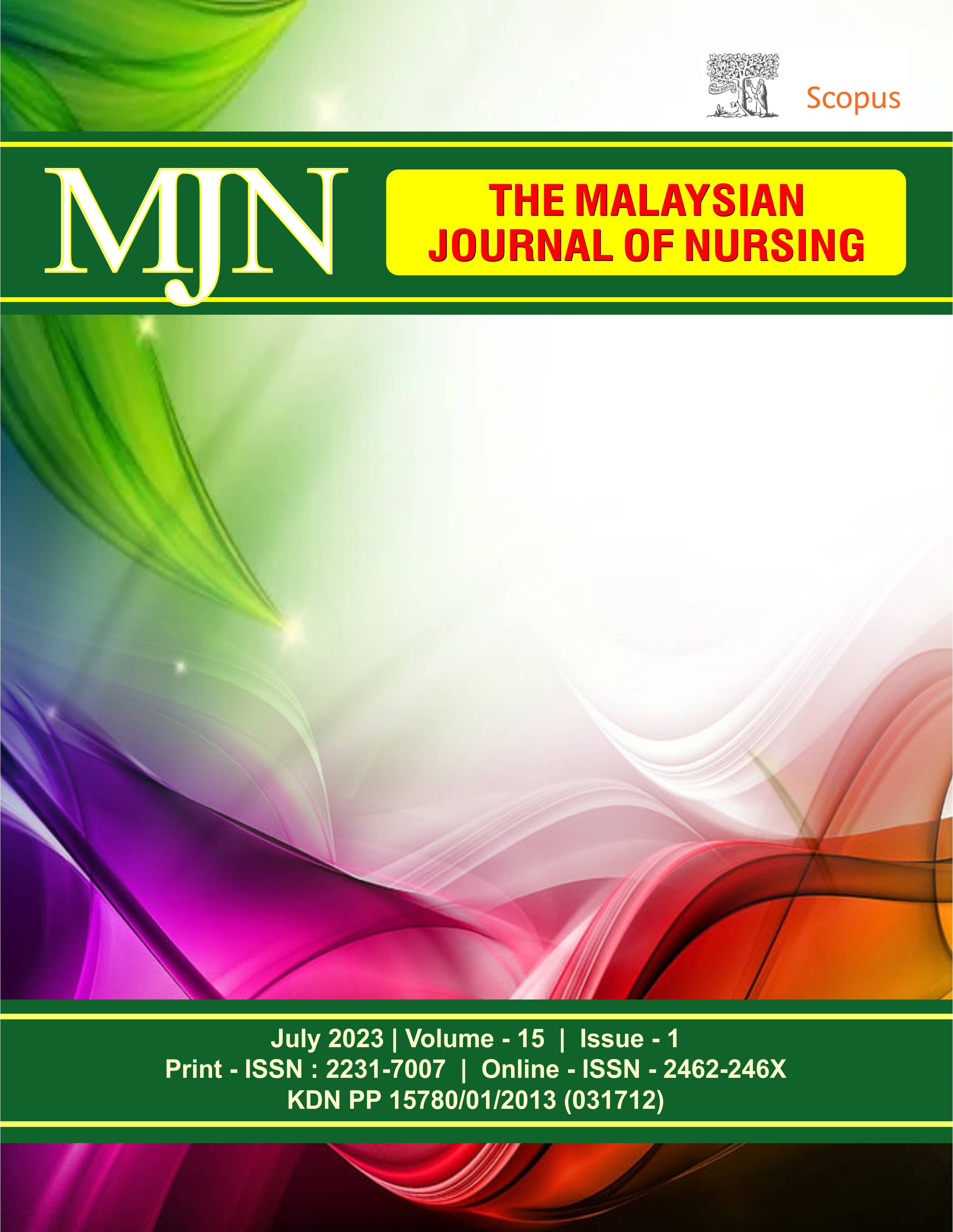Effectiveness of Yoga on Adolescent’s Menstrual Pain and Quality of Life
DOI:
https://doi.org/10.31674/mjn.2023.v15i01.009Abstract
Background: Menstrual pain is a common gynaecological complaint due to an imbalance of progesterone. It may also affect the adolescent girl's quality of life. Physical and psychosocial problems such as abdominal cramps and fatigue during the menstrual period affect daily activities, social relationships, and the school’s academic performance. Yoga, one of the non-pharmacological therapies, is a technique to reduce menstrual discomfort. Aim: This study aims to see the effectiveness of yoga on adolescents' menstrual pain and quality of life. Methods: The study was quasi-experimental study with a group pre-test and post-test design. Prior to receiving yoga therapy, all respondents took a pre-test to measure their level of menstrual pain and quality of life. The yoga therapy consists of once-a-week yoga exercises for six consecutive weeks. All respondents followed the post-test to evaluate the yoga therapy. Results: On the pre-test, 49.5% of respondents experienced mild pain, and 16.2% experienced severe pain. After doing yoga therapy, 19% of the respondents did not experience pain, 52.4% experienced mild pain, and no respondents experienced severe pain. There is an effect of yoga therapy on adolescents' menstrual pain (p value = 0.0001). Meanwhile, 49.5% of respondents had low quality of life during the menstruation period. After yoga therapy, 48.6% of respondents felt low quality of life during the menstruation period. There is an effect of yoga on adolescents' quality of life during menstruation (p value = 0.0001). Conclusion: Regular yoga is an effective and recommended way for adolescents to reduce menstrual pain and improve their quality of life during the menstruation period.
Keywords:
Adolescent, Menstrual Pain, Quality of Life, YogaDownloads
References
Aiyegbusi, A. I., Adeagbo, C. A., & Uwem-Umoh, S. I. (2020). Comparative efficacy of core strengthening and stretching exercises on systemic and quality-of-life symptoms in adolescent college students with primary dysmenorrhea. New Nigerian Journal of Clinical Research, 9(16), 59. https://doi.org/10.4103/nnjcr.nnjcr_36_19
Amru, D. E., & Selvia, A. (2022). The effect of yoga on reducing menstrual pain in young women at the mitra bunda health institute. Midwifery Care Journal, 3(1), 22–29. https://doi.org/10.31983/micajo.v3i1.8191
Arakawa, I., Momoeda, M., Osuga, Y., Ota, I., & Koga, K. (2018). Cost-effectiveness of the recommended medical intervention for the treatment of dysmenorrhea and endometriosis in Japan. Cost Effectiveness and Resource Allocation, 16(1), 1–10.https://doi.org/10.1186/s12962-018-0097-8
Armour, M., Parry, K., Curry, C., Ferfolja, T., Parker, M. A., Farooqi, T., ... & Holmes, K. (2022). Evaluation of a web-based resource to improve menstrual health literacy and self- management in young women. Journal of Psychosomatic Research, 162, 111038. https://doi.org/10.1016/j.jpsychores.2022.111038
Azagew, A. W., Kassie, D. G., & Walle, T. A. (2020). Prevalence of primary dysmenorrhea, its intensity, impact and associated factors among female students’ at Gondar town preparatory school, Northwest Ethiopia. BMC Women's Health, 20, 1-7. https://doi.org/10.1186/s12905- 019-0873-4
Chang, S. F., & Chuang, M. H. (2012). Factors that affect self-care behaviour of female high school students with dysmenorrhoea: A cluster sampling study. International Journal of Nursing Practice, 18(2), 117–124. https://doi.org/10.1111/j.1440-172X.2012.02007.x
Eka Widiyanti, D. E. V. I. (2016). The Effect of Menstrual Pain (Dysmenorhea) on Daily Activities in Adolescents at SMP N 2 Ponorogo (Doctoral dissertation, Universitas Muhammdiyah ponorogo). http://eprints.umpo.ac.id/2166/, Accessed on October 17th, 2022.
Firdausi, L. Y., & Aini, E. N. (2018). Differences in the level of dysmenorrhea pain before and after doing yoga on students. Jurnal Informasi Kesehatan Indonesia, 4(1), 26-32.
Ganesh, B. R., Madhushree, P. D., & Andrea, R. H. (2015). Comparative study on effect of slow and fast phased pranayama on quality of life and pain in physiotherapy girls with primary dysmenorrhoea: Randomized clinical trial. International Journal of Physiotherapy and Research, 3(2), 928-37. https://doi.org/10.16965/ijpr.2015.115
Günebakan, Ö., & Acar, M. (2023). The effect of tele-yoga training in healthy women on menstrual symptoms, quality of life, anxiety-depression level, body awareness, and self-esteem during COVID-19 pandemic. Irish Journal of Medical Science (1971-), 192(1), 467-479. https://doi.org/10.1007/s11845-022-02985-0
Habibi, N., Huang, M. S. L., Gan, W. Y., Zulida, R., & Safavi, S. M. (2015). Prevalence of primary dysmenorrhea and factors associated with its intensity among undergraduate students: a cross-sectional study. Pain Management Nursing, 16(6), 855-861. https://doi.org/10.1016/j.pmn.2015.07.001
Hailemeskel, S., Demissie, A., & Assefa, N. (2016). Primary dysmenorrhea magnitude, associated risk factors, and its effect on academic performance: Evidence from female university students in Ethiopia. International Journal of Women’s Health, 8, 489–496. https://doi.org/10.2147/IJWH.S112768
Harris, T., & Hardin, J. W. (2013). Exact Wilcoxon signed-rank and Wilcoxon Mann–Whitney ranksum tests. The Stata Journal, 13(2), 337-343. https://doi.org/10.1177/1536867X1301300208
Karmakar, M., Panduragan, S. L., Mohd Said, F. B., & Poddar, S. L. (2023). Impact of menstrual distress during menstruation to promote coping strategies. In B. Parimal & K. Gupta (Eds.), Perspectives on Coping Strategies for Menstrual and Premenstrual Distress (pp. 212- 236). IGI Global. https://doi.org/10.4018/978-1-6684-5088-8.ch012
Kertapati, Y., Sahar, J., Nursasi, A. Y., & Mutyah, D. (2022). The effect of chair yoga with spiritual intervention on the life satisfaction of older adults. The Malaysian Journal of Nursing (MJN), 14(2), 60-66. https://doi.org/10.31674/mjn.2022.v14i02.011
Khusnul K.D. (2019). “The Effect of Giving Yoga on Reducing the Intensity of Menstrual Pain (Dysmenorrhea) in Young Women at MTsN Sidorejo Kab. Madiun By: Dewi Khusnul Khotimah Nursing Study Program.” In Madiun, 117. http://repository.stikes-bhm.ac.id/650/, Accessed on November 18th, 2021.
Kucukkelepce, D. S., Unver, H., Nacar, G., & Tashan, S. T. (2021). The effects of acupressure and yoga for coping with premenstrual syndromes on premenstrual symptoms and quality of life. Complementary Therapies in Clinical Practice, 42, 101282. https://doi.org/10.1016/j.ctcp.2020.101282
Larasati, T. A., & Alatas, F. (2016). Primary dysmenorrhea and risk factors for primary dysmenorrhea in adolescents. Jurnal Majority, 5(3), 79-84. https://juke.kedokteran.unila.ac.id/index.php/majority/article/view/1040, Accessed on September 19th, 2022.
Manurung, M. F., & HD, S. R. H. R. (2015). The Effectiveness of Yoga Against Dysmenorrhea Pain in Adolescents. Jurnal Online Mahasiswa (JOM) Bidang Ilmu Keperawatan, 2(2), 1258- 1265. https://jom.unri.ac.id/index.php/JOMPSIK/article/view/8291/0, Accessed on September 19th, 2022.
Matthewman, G., Lee, A., Kaur, J. G., & Daley, A. J. (2018). Physical activity for primary dysmenorrhea: a systematic review and meta-analysis of randomized controlled trials. American Journal of Obstetrics and Gynecology, 219(3), 255-e1. https://doi.org/10.1016/j.ajog.2018.04.001
McGovern, C. E., & Cheung, C. (2018). Yoga and quality of life in women with primary dysmenorrhea: a systematic review. Journal of Midwifery & women's Health, 63(4), 470-482. https://doi.org/10.1111/jmwh.12729
Nurwana, N., Sabilu, Y., & Fachlevy, A. F. (2017). The effectiveness of yoga against dysmenorrhea pain in adolescents. Jurnal Ilmiah Mahasiswa Kesehatan Masyarakat Unsyiah, 2(6). https://dx.doi.org/10.37887/jimkesmas.v2i6.2873, Accessed on December 9th, 2022.
Ozerdogan, N., Sayiner, D., Ayranci, U., Unsal, A., & Giray, S. (2009). Prevalence and predictors of dysmenorrhea among students at a university in Turkey. International Journal of Gynecology and Obstetrics, 107(1), 39–43. https://doi.org/10.1016/j.ijgo.2009.05.010
Pal, S., Mandal, M., & Poddar, S. (2023). Coping Strategies for Menstrual and Premenstrual Distress: An Overview. Perspectives on Coping Strategies for Menstrual and Premenstrual Distress, 133-155. https://doi.org/10.4018/978-1-6684-5088-8.ch008
Prabhu, S., Nagrale, S., Shyam, A., & Sancheti, P. (2019). Effect of yogasanas on menstrual cramps in young adult females with primary dysmenorrhea. International Journal of Physiotherapy and Research, 7(4), 3129- 3134. https://dx.doi.org/10.16965/ijpr.2019.140
Rini, F. S., & Nuryanti, Y. (2021). The Effect of Yoga on Dysmenorrhea in Young Women at the Sirojul Mubtadi'in Islamic Boarding School in 2020. Simposium Nasional Mulitidisiplin (SinaMu), 2. http://dx.doi.org/10.31000/sinamu.v2i0.3243.g2233
Sari, K., Nasifah, I., & Trisna, A. (2018). The Effect of Yoga on Menstrual Pain in Young Women. Jurnal Kebidanan, 103-115. https://doi.org/10.35872/jurkeb.v10i02.283
Tsonis, O., Gkrozou, F., Barmpalia, Z., Makopoulou, A., & Siafaka, V. (2021). Integrating lifestyle focused approaches into the management of primary dysmenorrhea: impact on quality of life. International Journal of Women's Health, 327-336. https://doi.org/10.2147/IJWH.S264023
Unniraman, P., Changran, K. M., & Unnikrishnan, P. (2015). Effect of Yoga on menstrual problems in Adolescents. International Journal of Yoga and Allied Sciences, 4(1), 15–21. http://indianyoga.org/wp-content/uploads/2015/05/v4-issue1-article3.pdf, Accessed on November18th, 2021.
Unsal, A., Ayranci, U., Tozun, M., Arslan, G., & Calik, E. (2010). Prevalence of dysmenorrhea and its effect on quality of life among a group of female university students. Upsala Journal of Medical Sciences, 115(2), 138–145. https://doi.org/10.3109/03009730903457218
Wardani, I. G. A. N., & Suryanti, P. E. (2020). Yoga as an Effort to Relieve Menstrual Pain in Adolescent Girls. Jurnal Yoga dan Kesehatan, 3(2), 195 202.https://doi.org/10.25078/jyk.v3i2.1747
World Health Organization (WHO). (2014). Action for the Rights of Children (ARC) Child and Adolescent Development-Revision Child and Adolescent Development CONTENTS. Child and Adolescent Development, 1–131. https://www.unhcr.org/media/action-rights-children-arc- foundations-child-and-adolescent-development. Accessed on18th November, 2021.
Wulandari, A., Hasanah, O., & Woferst, R. (2018). Description of the incidence and management of dysmenorrhea in young women in the fifty city districts of Pekanbaru. Jurnal Online Mahasiswa (JOM) Bidang Ilmu Keperawatan, 5(2), 468-476.https://jom.unri.ac.id/index.php/JOMPSIK/article/view/21161, Accessed on December 9th, 2022.
Varni, J. W. (2023). Scaling and Scoring of the Pediatric Quality of Life Inventor, PedsQL, Mapi Research Trust. Version 21.3: March 2023 https://www.pedsql.org/PedsQL-Scoring.pdf. Accessed on November18th, 202
Published
How to Cite
Issue
Section
License
Copyright (c) 2023 The Malaysian Journal of Nursing (MJN)

This work is licensed under a Creative Commons Attribution-NonCommercial-NoDerivatives 4.0 International License.



































